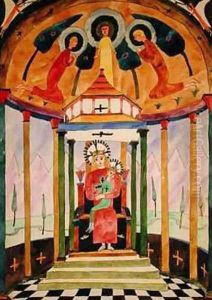Paul Goesch Paintings
Paul Goesch was a German architect, painter, and visionary artist, born on August 24, 1885, in Schwerin, Germany. He is known for his unique contributions to art, which were deeply influenced by his struggles with mental health and his experiences within the psychiatric institutions of his time. Goesch's work is often associated with the Art Brut and Outsider Art movements, although he was professionally trained as an architect at the Technical University of Munich, which sets him apart from many other artists in these categories.
Goesch's architectural career was interrupted by his mental health issues, leading to multiple hospitalizations. It was during these periods of confinement that he devoted himself to painting, developing a distinctive style characterized by vivid colors, fantastical landscapes, and intricate, often symbolic, details. His work reflects a rich inner world, with influences ranging from spiritualism to early expressions of psychoanalytic thought, which was burgeoning at the time.
In the 1920s, Goesch became involved with the anthroposophical movement, which was founded by Rudolf Steiner. This influence is evident in his art, which often explores themes of cosmic spirituality and transcendental experiences. Despite his professional background in architecture and his engagement with spiritual and philosophical movements, Goesch remained relatively isolated in terms of his artistic career, largely due to his ongoing mental health challenges.
Tragically, Paul Goesch's life and career were cut short by the political climate of his time. As part of the Nazi regime's eugenics policies, Goesch was a victim of the Aktion T4 program, under which he was murdered on August 22, 1940, in the Brandenburg Euthanasia Centre. His death is a stark reminder of the countless lives lost to the atrocities of the era, many of whom were artists, intellectuals, and individuals with disabilities or mental health issues.
Despite the tragic end to his life, Paul Goesch's work has posthumously received recognition and has been exhibited in various venues dedicated to Outsider Art and Art Brut. His legacy is preserved through his contributions to both the fields of art and architecture, offering insight into the profound ways in which personal struggle, spiritual exploration, and creative expression can intersect.

